Rose Laird
Continued onto: Rose Laird (post 1935)
Now largely forgotten, Rose Laird was once well-known as a beauty expert. A tireless promoter of her business, she made numerous appearances in department stores and salons across the United States and elsewhere, giving lectures, talks and demonstrations to a wide range of people, young and old, in person, through newspaper reports and by her radio broadcasts. Her prodigious travels by land, sea and air, within the United States and overseas, are reflected by her being the first woman in the beauty industry to make the transatlantic crossing in the new Pan American Air Service that began in 1939.
Published stories about Rose Laird’s early life show some similarity with those written about her contemporaries, Elizabeth Arden and Helena Rubinstein. Like theirs, these often suggested that she started in the medical field before turning to the beauty industry, the article below from ‘The American Weekly’ (1947) being a good example.
Rose Laird was the daughter of Glover Glaser, a chemist. Born in Philadelphia, she enrolled at the skin clinic of Jefferson Hospital as a student nurse, upon her graduation from high school. She aspired to be a dermatologist, specializing in diseases of the skin at a time when women doctors were rare.
Her career was deflected by marriage to F. Raymond Laird, an inventor. He patented a “dime savings bank.” Money couldn’t be shaken out of them. They opened of their own accord when the exact capacity of each was reached.
The banks found a vast and eager public and the inventor reaped a fortune. But he over-extended himself in stock market speculation; the panic of 1903 came; and he lost his money, lost his business and lost his health.
Mrs. Laird had some money of her own—$26. And an idea. She meant to capitalize on what she had learned about the care and treatment of the scalp and skin. She had some jars of creams and bottles of lotions which she concocted herself from formulas devised by her father.
She bought a ticket to New York, registered at a cheap hotel and looked for a one-room office, such as a doctor might use, in a desirable location.
She found one in West 31st Street, just off Fifth Avenue, one flight up. It had hot and cold running water and a wash bowl. She found a second-hand barber’s chair and purchased it with a down payment.(“Girls with big ideas—beauty unlimited,” 1947)
This origin story is a mixture of fact and fiction. Rose Laird was born in Werdau, Germany not Philadelphia and her family name was Graeser not Glaser. She emigrated to the United States in 1885 with her parents, Herman Robert Graeser [1847-1933] and Pauline Ernestine Graeser [1847-1915] (née Gross) along with other members of her immediate family. The 1900 census has Rose was living in Philadelphia with her parents, five siblings – Clara Williams [1871-1929], Theodore Herman [1873-1941], Richard Herman [1877-1914], Otto Herman [1881-1960], and Emmaline (Emily) [1887-] – and a child listed as her parents grandson. Two additional siblings, Martha Graeser [1870-1942] and Elise Gertrude Graeser [1875-1949], lived elsewhere.
The 1900 census also lists Rose’s occupation as housekeeper. It is possible that she began training as a nurse between 1900 and her marriage to Francis Raymond Laird [1863-1906] in April, 1902 but I note that other stories claimed that she worked as a hospital entry clerk, that she spent nine years in a health and cancer clinic studying skin diseases and that she was a registered nurse.
The dime savings bank invented by F. Raymond Laird did exist. He sold it through his business at 1018 Chestnut Street, Philadelphia through to 1890 before going into a partnership which quickly failed or was dissolved in 1891.
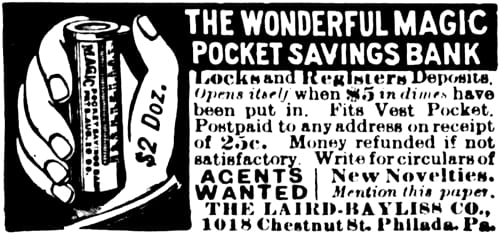
Above: 1891 Magic Pocket Savings Bank.
After they married, Rose and F. Raymond Laird moved to New York where they established the Laird Manufacturing Company (capital US$50,000) in May, 1903 to manufacture toilet articles. This means that Rose did not travel to New York on her own and start a beauty business with limited resources as ‘The American Weekly’ article claims.
The panic of 1903, also known as the Rich Man’s Panic of 1903, did happen but took place in September, 1903, some months after the Laird Manufacturing Company had been founded. F. Raymond Laird may have lost money in the 1903 stock market crash but it does not appear to have adversely affected the newly established business.
The Laird Manufacturing Company began advertising its products and treatments almost immediately after the company was established. It sold its products through a salon which opened at 147 West 23rd Street in 1903 as well as Macy’s, New York; Abraham and Straus, Brooklyn; and Plaut and Co., New Jersey.
The salon moved to 20 West 31st Street later in 1903 and remained there until 1914 at least but had shifted to 17 East 48th Street by 1916. It continued there until 1928 when it moved to 785 Fifth Avenue.

Above: 1930 Treatment room at the Fifth Avenue salon. This could be a specialist electrical treatment room or has been set up with a lot of equipment to make the facilites look impressive.
Products
Early advertised products included: Solvo, a depilatory; a tissue food, which I assume was Laird’s Nutrient Skin Cream; and a hair restorer, possibly Laird’s Hair Go’ Tonic. However, it seems likely that Rose Laird had other cosmetics in her inventory as she treated dandruff, freckles, and grey or faded hair in the salon.
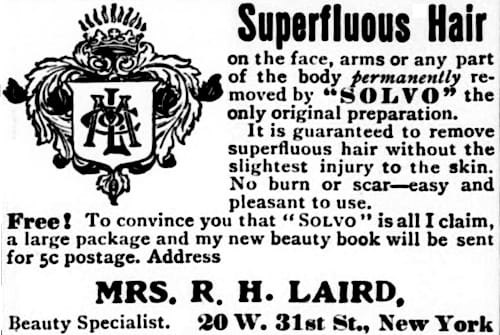
Above: 1903 Laird’s Solvo. Most early advertisements included a shield emblazoned with L M Co., the initials of the Laird Mfg. Co.
Where Rose Laird acquired the necessary knowledge to operate a beauty salon is a mystery as I have nothing to suggest that she had worked in the beauty industry before 1903. However, she was not the only woman to start a beauty salon from scratch, Helena Rubinstein did the same thing in Melbourne in 1902. I also note that skin-care and hair-care practices were a good deal simpler at the turn of the century than they were later on. This particularly applies to hair-care in the days before the arrival of the permanent wave.
Hired treatment girls worked in the salon and Rose was also supported by her younger sister Emily (Emmaline). In a 1915 census, Emily was listed living with Rose in New York and working as a hair dresser. She remained with the business through to at least 1950. Rose may also have gotten some help from her brother Otto. He worked as a druggist for many years and may have played a part in formulating her cosmetics.
The Rose Laird salon offered a range of treatments for the skin, scalp and hair including the Vita Electro Treatment. This probably used faradic currents to electrically contract the facial muscles. This was believed to firm the muscles and flabby skin and reduce or prevent wrinkles.
See also: Faradic Treatments
Francis Laird died in February, 1906 leaving Rose and her sister to continue the business. Louis Harris Kingstone [1881-1932] would join the firm later on. He had arrived from London in 1907 and worked in the Boericke & Runyon Homeopathic Pharmacy at 518 6th Avenue, New York for a number of years before joining Rose Laird. He became the president of the Rose H. Laird Company when it was established in 1912 and married Rose in 1916. During this time, Rose established a pattern of travelling widely across America, opening new outlets for her products or viisting those that already carried them. Kingstone’s familiarity with Britain probably helped the company establish outlets there in the 1920s and the company also signed up distributors in Canada, South America, and South Africa.
Beauty principles
Laird based her facial treatments on the idea that wrinkles, lines and loss of facial contours were the result of muscle weakness, a belief widely held in the first half of the twentieth century and which still has adherents today. She recommended preventative treatments to avoid youthful lines being lost and restorative treatments to help rectify any damage that had already occurred.
If the contour of the face has already lost its lines and flabbiness has set in, no time should be lost to repair the mischief. We are so apt to go along the lines of least resistance. Nature intended the muscles of the body to be exercised. Our young people of today, consider sports to be part of their daily routine. That accounts for the splendid physique of modern budding womanhood, as compared with the frail, delicate ladies of the preceding generation.
(Rose Laird, 1928, p. 5)
Although she would later change her mind, Rose Laird initially preached that facial muscles could not be firmed by the sort of physical exercise used to firm body muscles.
For obvious reasons, no physical exercise can be devised that would keep these [facial] muscles firm and so prevent them for sagging. Now the muscles of the face and neck will sag and do sag, due to this lack of exercise, and age becomes immediately apparent.
(Rose Laird, 1928, p. 6)
Rose Laird’s solution to this problem was to substitute massage for exercise. Massage was once widely thought to have a revitalising effect on muscles, second only to exercise in strengthening muscle tissues by its direct effects on the muscles and nerves and through the increased blood flow it produced.
See also: Massage, Wrinkles and Double Chins
The massage routine developed by Laird used nine movements which were described by her as the ‘Nine Essential Facial Exercises’.
Hollowed cheeks
1. Start we the middle of the chin, using the three long fingers of each hand, rub outward and upward with a firm but gentle touch towards the middle of the ears. In all the Facial Exercises use a rotary motion covering a circle about the size of a silver dollar.
Tell-tale lines of worry
2. Then start at the corner of the mouth and rotate outward and upward towards the hose at the nostrils. …
Drooping lines
3. Continue across the checks, upwards to the tops of the ears. …
Relaxed muscles of the eyelid
4. With the eyes, start at the comer near the nose and rotate around the eyes very gently in a complete circle, first half circle over the eyes just under the eyebrows. …
Lines on the forehead
5. With the forehead. Start in the center and rotate outward and up towards the temple. …
This will remove the horizontal lines.
Eradicating crow’s-feet
6. At the corners of the eyes, rotate outward and up towards the temples. …
The nose is the first to reflect beauty
7. The nose, rub gently upward and outward with considerable pressure using the middle fingers, and manipulating from the tip along the sides of the bridge to the top. Rotate well at the base and at the sides of the nostrils. …
The graceful lines of the throat
8. To restore the firm contour of the throat and neck, rotate the muscles firmly in a slanting direction from under the chin towards the shoulders.
9. And, from the middle of the threat backward and upward towards the under side of the ears.(Rose Laird, 1928, pp. 10-12)
These exercises were to be done for ten-minutes every night before retiring, followed in the morning with a facial cleansing cream, an astringent and an ice rub.
Also see: Winning beauty from the passing years (1928)
Like Eleanor Adair and Elizabeth Arden, Laird also recommended patting when applying some of her products such as astringents using a rolled up four-inch square of cotton wool rather than a ready-made patter. However, unlike others in the industry, I have no evidence that she advocated strapping or sold chin straps.
See also: Patters and Straps, Bandages and Tapes
Skin-care
The nine essential facial exercises were supplemented with Rose Laird cosmetics. Skin cleansers were used to clear the pores and dislodge impurities; astringents and tonics helped tone relaxed muscles and tighten sagging facial contours; and a nutrient cream made with almond oil and a muscle oil were used to build up underlying tissue which helped to banish or prevent wrinkles.
Some of the Rose Laird skin-care products available by 1930 are as follows. Those that are ‘carbolized’ may have contained a phenolic antiseptic.
Liquid Pore Cleanser: “[W]ill not only cleanse the skin but will purify the pores and at the same time act as a skin tonic.”
Cleansing Oil: “[A] blending of Oriental oils combined with lemon … will eliminate all secretions from the pores and at the same time strengthen the muscles of the face and neck juice.”
Cream Vi-o-lay: “[A] greaseless emulsion of fine vegetable oils, the one creamy cleanser that can be used successfully on the over-oily skin—at the same time very beneficial for the normal skin.”
Nutrient Skin Cream: “[A]n ideal skin food … Apply with the tips of fingers, using both hands at the same time and exercise as per ‘Nature’s Nine’ Facial Exercises … After a few minutes of the exercise allow … to remain on all night, or as long as convenient.”
Bleach and Freckle Cream: “[H]as a decided bleaching effect, and peels off the dead cuticle that clogs the pores of the skin.”
Toilette Astringent: “[T]o tone the relaxed muscles … preferably with ice … will freshen and tighten the skin, tone the muscles and give the complexion that healthful appearance that one associates with the well groomed woman.”
Special Face Lotion (Carbolized): “[W]ill leave a coating of powder, which can be dusted off as required … be very sure to apply before going outdoors, to prevent windburn and sunburn.” Shades: White, Flesh, Rachel, Brunette, and Peach.
Special Cream for Enlarged Pores: “[W]ill loosen and gradually eliminate the secretions, bringing the pores back to a normal condition.”
Ether Skin Lotion: “[A]bsorbs the superfluous oils.”
Special Ointment (Carbolized) for the Skin: “Rub well into the skin, particularly where the pimples and blackheads are most in evidence and allow to remain on during the sleeping hours. Also use where the skin is chapped or sore.”
Reducing Chin Cream: “[V]ery successful for reducing and eliminating double chins and adjusting loose and flabby tissue. Its action is to dissolve the superfluous fat and bring about a firm even contour.”
Blemish Banisho: “[I]ts action is gradual, and should be followed by Skin Bleach and Freckle Cream.”
Muscle Oil: “[R]ecommended for persistent wrinkles, fine lines on the forehead and crow’s feet.”
See also: Skin Tonics, Astringents and Toners, Skin Foods and Muscle Oils
By 1927, Rose Laird had added a number of skin-care cosmetics containing extracts from calendula flowers (marigolds). Long used in traditional medicine as an anti-inflammatory and skin soother, calendula is found in many cosmetics today but, as far as I can tell, Rose Laird was the first that I know of to use it in cosmetics.
Marigold Skin Cream: “[W]ill eliminate sagging muscles, wrinkles, facial blemishes and enlarged pores.”
Marigold Skin Lotion: “[A] mild cleanser, as gentle as rain water.”
Marigold Astringent Cream: “An invaluable Cream for delicate skins, containing the curative properties of Calendula Flowers.”
Marigold Skin Tonic: “A Calendula Flower Tonic—delightful and astringent.”
Marigold Hand Lotion: “A boon to chapped hands and a truly wonderful tonic that will smooth wrinkled hands and whiten the skin to its natural transparent beauty.”
Marigold Soap: “Specially prepared for the hands and delightful for the bath.”
Hands and nails
Marigold Soap and Marigold Hand Lotion were recommended for the hands while Nail and Cuticle Cream could be used to treat the nails and dry cuticles.
Nail and Cuticle Cream: “[B]uilds up nails that are cracked, brittle, dry and ridged, and it eliminates the unhealthy dry cuticle that occasions hang-nail.”
Make-up
Until the 1930s, Rose Laird was more interested in skin, scalp and hair-care than make-up. She did sell a limited range of face powders, rouges and lipsticks but her cosmetics did not appear to include eye make-up except for an Eyebrow Pencil.
Early Rose Laird make-up consisted of: Face Powder, either loose or compact (Naturelle, Rachel, Brunette, Peach, Illusion, Ochre, and White shades) kept on with Greaseless Skin Cream, a type of vanishing cream; Invisible Face Lotion, a liquid powder, worn in the evening to cover the arms, neck and shoulders (White, Flesh, Rachel, Peach, Illusion, and Brunette); Rouge in Liquid (Medium, and Light), Cream, or Compact forms (Light, Medium, Dark, and Raspberry); and Lipstick (Light, Medium, Dark, and Illusion).
For eyebrows there was Eyebrow and Lash Cream, to promote lustre and growth, Fixatol to discipline unruly, ill-shaped eyebrows, an Eyebrow Brush, and the previously mentioned Eyebrow Pencils.
1930s
Rose Laird agreed to endorse Palmolive Soap in 1930 in advertisements that ran into 1931. I assume this brought in some much needed cash in a time of economic difficulty but the Palmolive promotion would also have helped raised Rose Laird’s standing as a beauty expert.
The following year saw the death of Louis Kingstone with funeral services held at the Free Synagogue House, 40 West Sixty-Eighth Street, New York. By then, the Great Depression had set in and sales had dropped. In 1933, Rose Laird responded the falling demand by repackage its entire cosmetic range in 1933 in the hope that the more modern-looking containers would get more attention.

Above: 1933 Rose Laird cosmetics repackaged in green and white. The bottom half of the bottle labels have a green background while the powder, rouge, lipstick and mascaro containers are green with gold RL monograms.
Rose Laird also began conducting radio talks over WOR, New York in 1933. After getting positive sales results she increased her use of radio which were extended into Philadelphia, Chicago, Boston, Detroit, Baltimore, and Pittsburgh by 1935. The move into radio advertising came with a corresponding decline in print advertising, most of which was now done in cooperation with stores. However, some long-standing promotional practices remained. The company continued to use demonstrators and Rose also maintained her relentless rounds of personal appearances.
Skin-care
Rose Laird made a number of changes to her skin-care routines in the 1930s. She now claimed that traditional facial massage stretched the skin and that patting flattened facial muscles. Consequently, she replaced her Nine Essential Facial Exercises with a series of more forceful movements that involved pinching, vibration, and what came to be known as knuckle massaging.
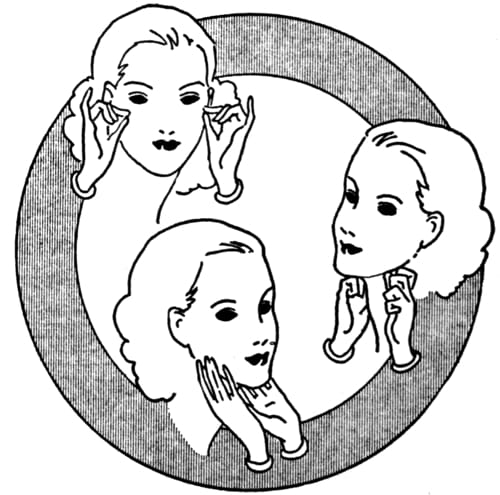
Above: 1933 Rose Laird. Pinch your way to beauty.
First smooth your cream lightly over the surface of your face. Then with thumb and first finger (as shown in the sketch) take small, deep pinching movements.
Do not pinch just the surface of the skin. Lift up the flesh to get at the relaxed muscles and stimulate circulation. Begin at the lower corner of the mouth. Work up along the expression line to the corner of the nostril.
The lady sketched at the right side of the circled layout is making a fist with which she will knead out suggestions of stringy muscles of the throat and skin, and also tone up her contour line. Do like wise and place the second joints of your fist against your face where the muscles tend to droop.
This series ends, apparently, with a prayer. Place your hands as in prayer, separate the tips of your fingers, place on either side of your chin. Then with a somewhat pushing of vibratory movement, work up the jawline to the tips of the ears. Then separate the fingers to place one behind the ear and the rest in front of the ear. Hold that position for a minute, then repeat.(Rose Laid advertorial, 1933)
Laird also changed her mind about facial exercises adding a series of ‘Facial Gymnastic’ routines to strengthen the facial muscles very similar to those promoted decades earlier by other beauty practitioners.
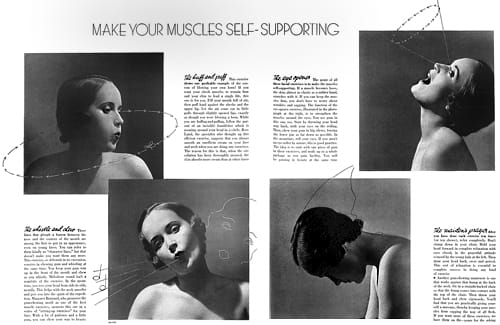
Above: 1934 Rose Laird facial exercises to make the muscles self supporting. The huff and puff, whistle and chew, eye opener, and maiden’s prayer.
See also: Facial Gymnastics
There were also some skin-care additions to the Rose Laird range. In 1934, the amber-coloured Am-ber-ain was added to Rose Laird’s existing cleansers – Cream Vi-o-lay, Cleaning Oil, Marigold Skin Lotion, and Liquid Pore Cleanser. After cleansing, clients could select from one of the following lubricating creams for the face and/or throat – Nutri-ol Skin Cream, Reducing Skin Cream, Plastic Cream, or Marigold Skin Cream. The Plastic Cream with ‘glandular derivatives’ appears to be new but the same cannot be said of Nutri-ol Skin Cream which was Nutrient Skin Cream renamed.
The Nutrient Skin Cream may have been renamed as Nutri-ol to bring it into line with other hyphenated named products in the range like Cream Vi-o-lay and Am-ber-ain. However, Rose Laird may also have been concerned by the legislative program developing in the 1930s that resulted in the Wheeler-Lea and the Food, Drug, and Cosmetic acts of 1938 which prohibited the use of names like nutrient cream for cosmetics. She also seems to have abandoned her Muscle Oil before 1938, another name proscribed by the new legislation.
Am-ber-ain: “[A] refreshing liquid cleanser, excellent for the over-oily skin, cleansing and toning, releasing clogged pores. May be used at anytime as it is not drying to the normal or dry skin.”
Plastic Cream: “Assists you to remould the throat and neckline to the firm youthful contour which is every woman’s right. … [C]ontains glandular derivatives necessary to ward off relaxed muscles of the throat and the distressing shirred or scrawny baggy under-chins.”
See also: The FDA, FTC and Cosmetic
Adolescent skin
Although menopausal women can suffer from pimples and acne these problems are more commonly associated with adolescent skin. Rose Laird already had a number of preparations to help with these conditions including Liquid Pore Cleanser, Carbolised Skin Ointment and the medicated Special Face Lotion but for more serious eruptions she now recommended Acnex Cream and Acnex Cleanser.
Acnex Cream was to be used at night while the Acnex Cleanser was to be used several times each day applied with a square of cotton wool saturated with the cleanser.
Acnex Cream and Acnex Cleanser: “Prophylactic preparations for the alleviation and prevention of skin blemishes.”
Sun-care
As far as I can tell, Rose Laird did not sell any sun-care specific cosmetics in the 1920s. The three-part program she developed in the 1930s included Rose Laird Sunburn Oil for promoting a tan, Sunburn Cream for preserving the normal skin colour, and a Sun-Soothe Cream for skins suffering from sunburn. Unfortunately, I have no information on their composition or whether any of them contained a sunscreen.
Sunburn Oil: “A bland emulsion for those who wish to acquire a rich bronze tan without burning or blistering. This oil keeps out the harmful rays which cause sunburn, allowing the healthy violet rays to give you an alluring tan.”
Sunburn Cream: “Keeps the complexion pearly white, prevents the harmful sunburning and tan producing violet rays from reaching your skin. Excellent powder base.”
Sun-Soothe Cream: “A quick relief from sunburn and sun blisters. Immediately soothes away the pain and normalizes the skin.”
Make-up
Rose Laird made a concerted effort to extend her make-up range in the 1930s as its used gained increasing acceptance. New shades were added to face powders, lipsticks and rouges, new forms of eye make-up were added, and coloured nail polishes were introduced.
Foundations and powders
Rose Laird could only recommended Laird’s Greaseless Foundation Cream as a powder base before she added Foundation Cream, probably just Greaseless Foundation Cream with an added pink tint.
Foundation Cream: “A non-greasy cream for the nose and chin—a doubly firm and lasting foundation. Tinted in a flattering soft, warm, rosy tone.”
Rose Laird had ten face powder shades in its inventory in 1934. This included older shades such as Naturelle, Rachel, and Brunette as well as newer tones such as Ochre Rose, Dark Brunette, Beachtan, and Rusglo with Lotus, Light Rusglo, Indian Umber, Indianglo, Cinnabar, and Carnelian introduced in 1935. Rose Laird recommended using a slightly darker shade of face powder than the shade of the skin, then using a lighter shade of powder to add highlights.

Above: Rose Laird Powder Box. An air-tight sifter box sitting over and dispensing powder on to a puff sitting in a drawer – a novel design.
In 1935, Rose Laird added Poudre Set, a semi-liquid cream that was applied over foundation and rouge to help conceal blemishes while giving the skin a velvety, matt finish. A darker shade would help maintain a tanned look through winter while a lighter shade could be used to ensure that the skin looked fair. I imagine that many women skipped the foundation and used Poudre Set in the same way that women would use the new liquid foundations that became popular after the Second World War.
Poudre Set: “Goes over make-up and sets it. Oil base. Dries quickly.” Shades: Lotus, Light Rusglo, and Tan.
Lipstick and rouge
Rose Laird continued to sell liquid, cream and compact rouges in the 1930s but added a wider variety of shades along with new shades of lipsticks.
Rose Laird generally recommended using a cream rouge or a liquid rouge if the skin was oily, suggesting that compact rouge should be reserved for touch ups during the day. Coral, Geranium, and Ruslgo were added to the existing Light, and Medium shades of Compact Rouge before Indian Flame, Carnelian, Indian Tan, Indian Summer, and Cinnabar shades were introduced in 1935. By then, Rose Laird Liquid Rouge came in Light, Medium, and Dark shades; Greaseless Rouge included Cinnabar, Rose Ideal, and Coral shades; and Cream Rouge included Indian Flame, Rusglo, Raspberry, and Cinnabar tones.
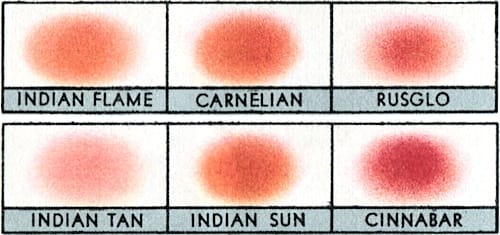
Above: 1935 Rose Laird Rouge shades.
New lipstick shades were added talong with rouges. These included Natural, Medium, Vivid, Light, Cherry, Orange, Raspberry, Rusglo (1933), and Plumpurple (1934), with Indian Flame, Carnelian, Indian Tan, Indian Sun, and Cinnabar added in 1935.
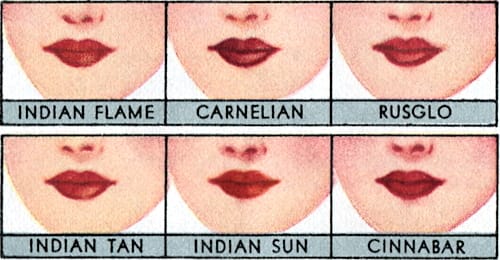
Above: 1935 Rose Laird Lipstick shades.
In 1935, Rose Laird appears to have repackaged her lipsticks in new twist up cases with a light top and added an automatic lipstick case for good measure.
As with light and dark shades of powder, Rose Laird recommended using lipstick and rouge to contour the face to make it look more appealing.
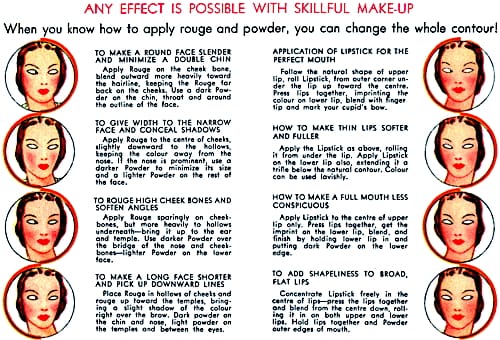
Above: Rose Laird contour techniques.
See also: To your natural beauty give protection (1935)
Eye make-up
As previously mentioned, I have no evidence for Rose Laird selling eye make-up in the 1920s except for an eyebrow liner. However, a block/cake mascara and a cream eyeshadow had appeared by 1933 at the latest. The mascara was referred to as a mascaro, a name used when these products were hair cosmetics, but this was dropped later on. She recommended using two brushes, one to apply the mascara, the other to separate the lashes. It did not smart so was probably made with triethanolamine rather than soap. It was also to be used for eyebrows, again using the two brush technique.
Eyeshadow: “A soft delicate cream giving that limpet look.” Known shades: Blue-Gray, Jade Green, Olive Green, Henna-Brown, and Purple.
Mascaro: “Lends an alluring veil to the eyes.” Shades: Blue, Green, Brown, Black, and Purple.
See also: Water Cosmetique (Mascaro) and Cake Mascara
Nail polish
Rose Laird had introduced a liquid nail polish in the 1920s but it probably only came as transparent or natural. The polishes came in a range of shades in the 1930s but I only have a record for one – Medium.
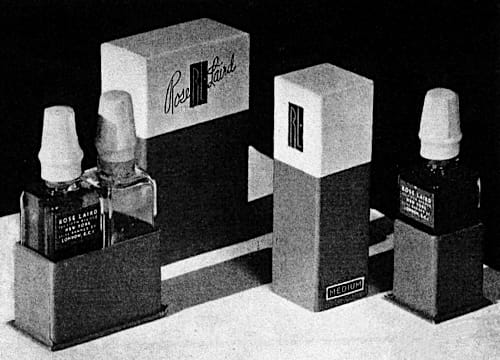
Above: 1935 Rose Laird Nail Polish.
The polishes were described as creamy and were colour coordinated with Rose Laird lipsticks. This suggests that they were opaque rather than transparent a developing trend in the 1930s.
See also: Nail Polishes/Enamels
Timeline
| 1903 | Laird Manufacturing Company established at 20 West 31st Street New York. New Products: Solvo. |
| 1912 | The R. H. Laird Company established in New York. |
| 1928 | New York salon moves to 785 Fifth Avenue. |
| 1933 | Rose Laird begins radio broadcasts. Rose Laird line repackaged. |
| 1934 | New Products: Am-ber-ain; and Quix-Set. |
| 1935 | New Products: Poudre-Set; and Automatic Lipstick. |
Continued onto: Rose Laird (post 1935)
First Posted: 17th May 2016
Last Update: 14th October 2023
Sources
Girls with big ideas—beauty unlimited. (1947, August 31). The American Weekly, p. 10.
Laird, R. (1935). Personalising cosmetics. The Drug and Cosmetic Industry. 37(1), 58-59.
Rose Laird. (1928). Winning beauty from the passing years [Booklet]. New York: Author.
Rose Laird. (1935). To your natural beauty give protection … to any blemish give correction [Booklet]. New York: Author.
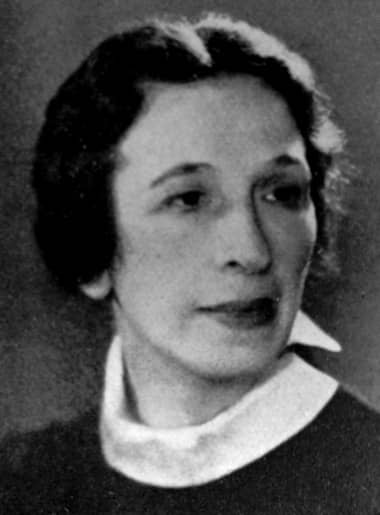
Rose Helen Laird (née Graeser) [1880-1966], later Rose Helen Laird Kingstone.
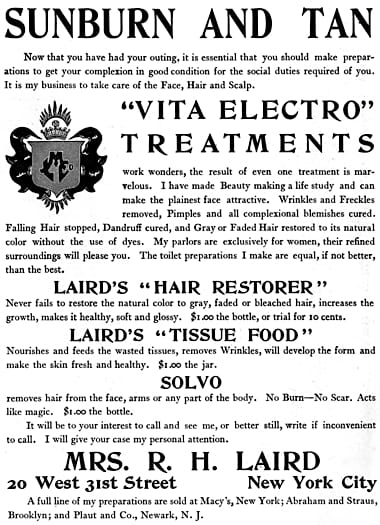
1903 Rose Laird Vita Electro Treatment.
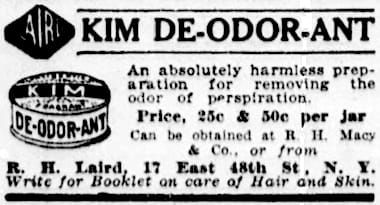
1917 Laird’s Kim De-Odor-Ant.
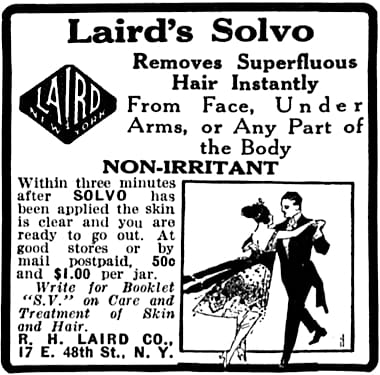
1919 Laird’s Solvo.
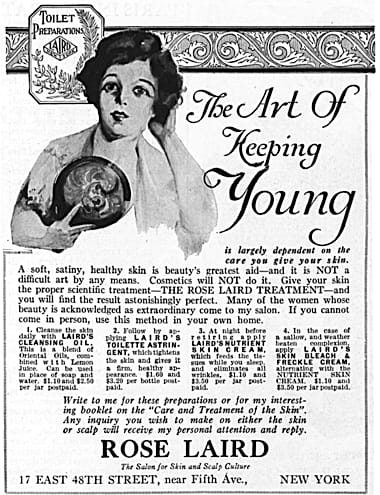
1920 Laird’s Cleansing Oil, Toilette Astringent, Nutrient Cream, and Skin Bleach & Freckle Cream.
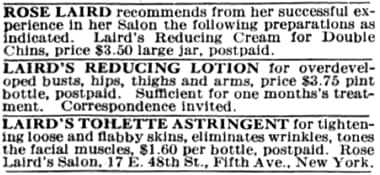
1920 Rose Laird.
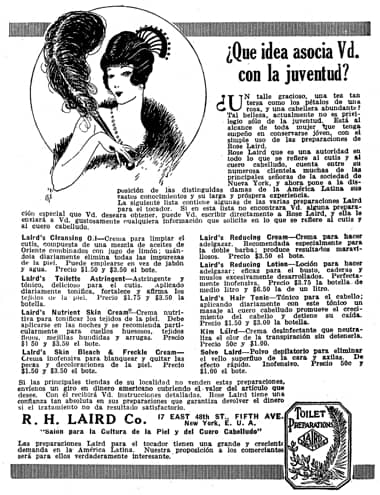
1921 Rose Laird.
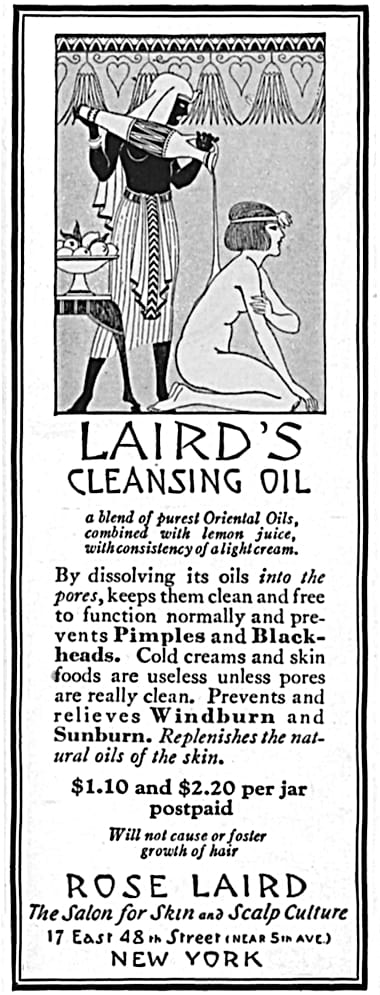
1922 Laird’s Cleansing Oil.

1922 Laird’s Nail and Cuticle Cream.
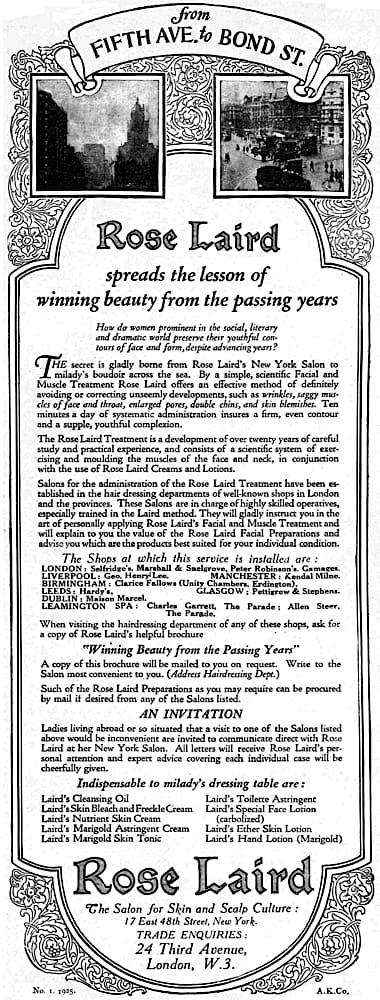
1925 Rose Laird (Britain).

1925 Rose Laird.
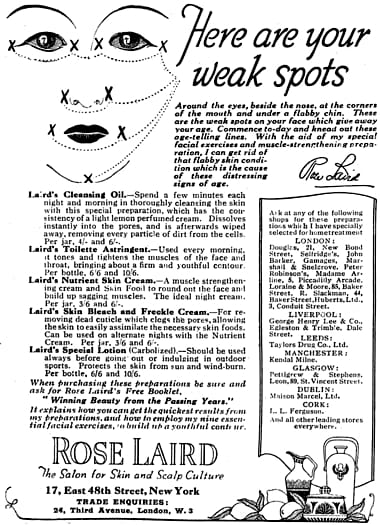
1925 Rose Laird (Britain).
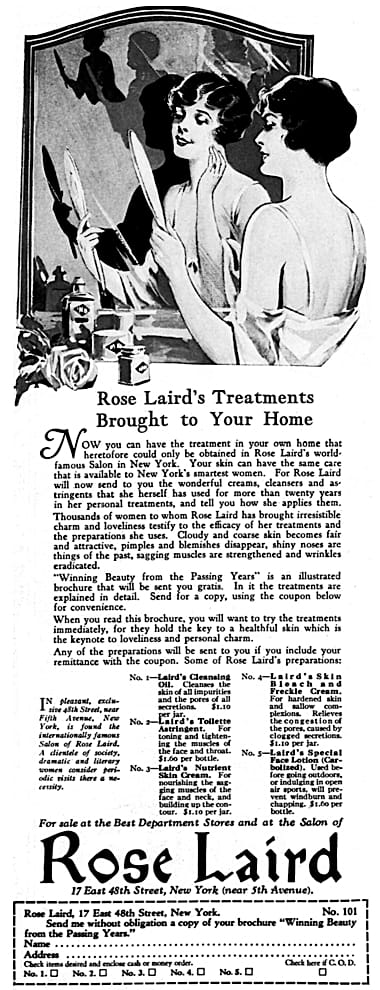
1926 Rose Laird.
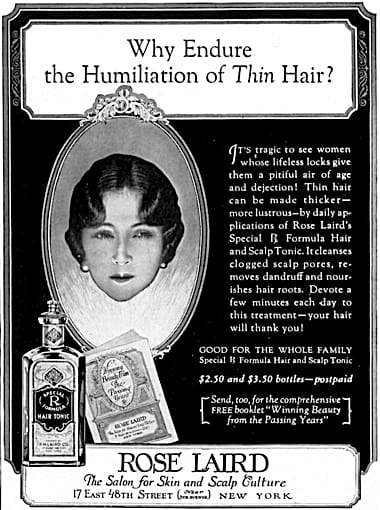
1927 Rose Laird.

1927 Rose Laird (Britain).

1927 Rose Laird Marigold Preparations.
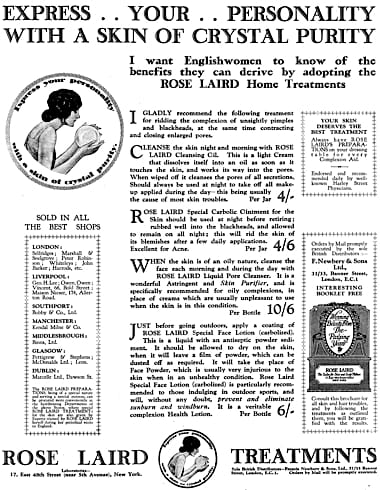
1928 Rose Laird (Britain)
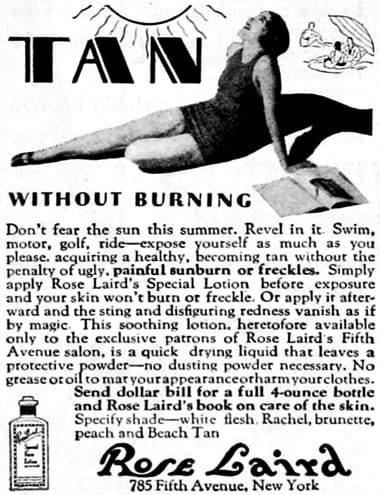
1930 Rose Laird Special Lotion.

1931 Rose Laird endorsement for Palmolive Soap.

1933 Rose Laird at Macy’s.
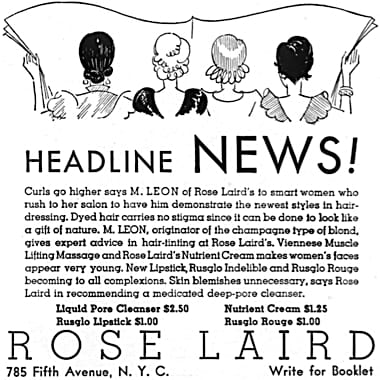
1933 Rose Laird.
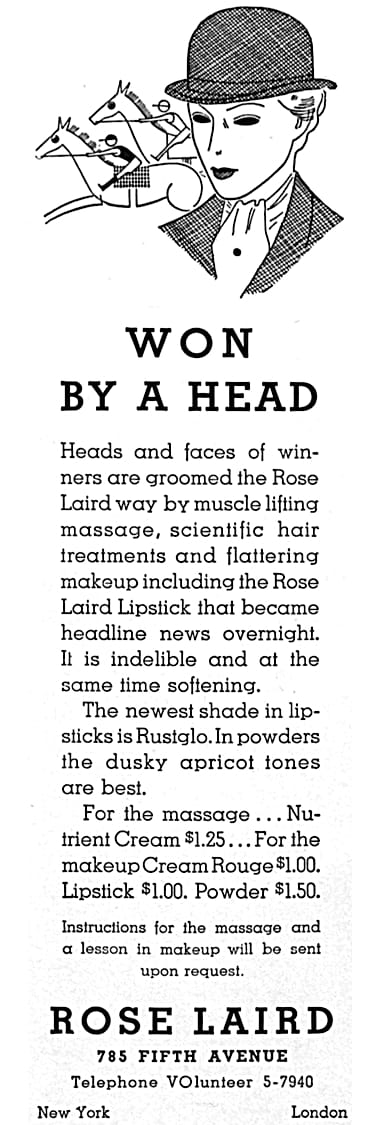
1933 Rose Laird Rusglo Lipstick.

1934 Rose Laird Cream Vi-o-lay and Tar Shampoo.

1934 Rose Laird Lipstick in a case that was superseded in 1935.

1934 Rose Laird Beauty Cocktail.

1935 Rose Laird Automatic Lipstick. There was space on the side for an engraved monogram.

1935 Rose Laird lipsticks at Macy’s in a new case.

1935 Emily Laird (Emily Graeser) acting as a demonstrator.
